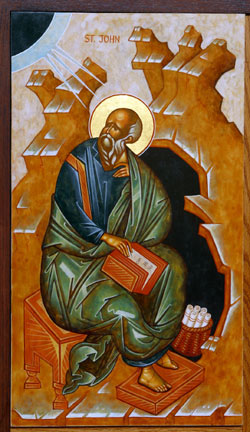
Life of St. John the Evangelist

The "Divine Dozen" who served Jesus Christ as his apostles comprised a band of spiritual giants whose comparison to one another invites scarcely more than an embarrassment. But the sentimental favorite seems to be St. John the Evangelist and Theologian, the apostle who looked into the dying eyes of our crucified Lord on that dark day at Calvary and received the Messiah's last request. An agonized John heard the final words from the Cross, entrusting to him the care of the Mother of God, the Virgin Mary, who was uppermost in the thoughts of her Son in his last moments of earthly life (John 19.26).
Born in Bethesda of Galilee, the son of Zebedee, John shared his apostolic mission with his brother the Apostle James, who died for Christ in Jerusalem. His mother's name was Salome, but he is affectionately referred to as having three mothers, the other two being Mary the Mother of Jesus and the symbolic Thunder (Boanerges). The latter applied to him by the Savior, as the son of Thunder, because he was rebuked for asking Christ to send down "fire from Heaven to punish the citizens of Samara that refused to admit him because he was going to Jerusalem" (Luke 9.53-56). He was in close personal contact with Jesus to the end, despite his extensive travels as an evangelist.
A dedicated apostle, John was chosen by Jesus Christ to accompany Him on the ascent of Mt. Tabor, the scene of the historic Transfiguration, and where Jesus was proclaimed by God to be "his beloved son." The personal ties with Jesus and his Mother were shared by Salome, John's mother, whose love for the Savior earned her a place among the saints as one of the seven myrrh-beading women who anointed the sacred body of Christ after his descent from the Cross.
John remained close to the Mother of the Savior throughout her lifetime and was at her side when she breathed her last on August 15, officiating at her burial in the Garden of Gethsemane, a spot made sacred by her Son years before. He was among the other disciples who discovered the empty tomb of Mary, who forty days after her death had been assumed into Heaven.
With his promise to Jesus for his Mother's care fulfilled, St. John now turned his full attention to carrying the message of Jesus Christ to the spiritually darkened areas of the then known world, preaching throughout Asia Minor with a passion that won converts who formed a solid base for the New Faith. Unlike the other eleven apostles, all of whom were martyred in the name of Jesus Christ, John lived to the ripe age of 105, escaping the fate of his brother evangelists. This remarkable durability provided for one of the longest services on record in the cause of Christ, a service which carried over into the second century which establishes him as a record holder in conversions to Christianity. Some estimates have it that he was personally responsible for winning over some 400,000 pagans to Christianity, a staggering figure considering that his audiences could never have been at best a few hundred and most of the time a lot less. Not even his uncle, St. Prophoros, who wrote about his nephew's travels, could have envisioned such a protracted mission for the Messiah.
John withdrew from the grueling pace of preaching in favor of the solitude of the beautiful island of Patmos in the Aegean Sea. There he refreshed his mind and body and found the tranquility in which it became possible to write that part of the holy Scriptures known as the Revelation, a profound and prophetic book of the New Testament. This holy work was done at the express bidding of God, who smote a huge cleft in a rock formation of a cave, still visible today, and commanded John to write this revealing segment of the Bible. On the spot where lightning struck the cave the Ecumenical Patriarchate of Constantinople maintains to this day a sacred shrine which has beckoned countless religious pilgrims to the island of Patmos.
After leaving Patmos, John turned up at Ephesos, where, in the course of writing the three epistles contained in the New Testament, he is said to have caused, through means of a prayer vigil, the destruction of a pagan temple dedicated to Artemis which is now the site of a beautiful cathedral. A true man of God, John is one of the most beloved figures of Christianity.
Through the prayers of Saint John, may the Lord Jesus Christ have mercy on us. Amen!
George Poulos, Orthodox Saints
Holy Cross Orthodox Press, Brookline Mass. 1991